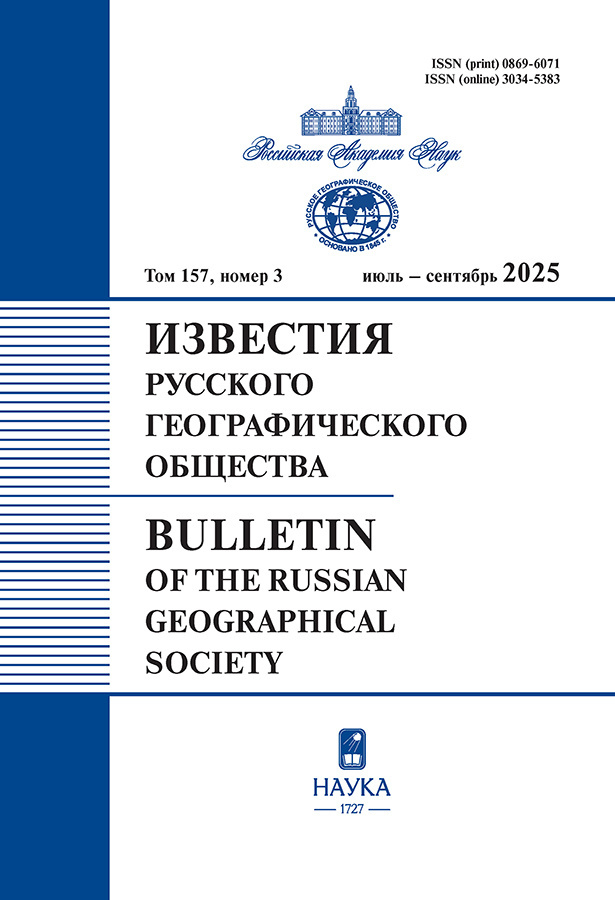Prospects for the use of renewable energy sources in the North of the Krasnoyarsk Territory
- Authors: Berezkin M.Y.1, Degtyarev K.S1, Sinyugin O.A1
-
Affiliations:
- Lomonosov Moscow State University
- Issue: Vol 157, No 3 (2025)
- Pages: 379-393
- Section: Articles
- URL: https://journals.eco-vector.com/0869-6071/article/view/691769
- DOI: https://doi.org/10.31857/S0869607125030085
- EDN: https://elibrary.ru/ltwnjc
- ID: 691769
Cite item
Full Text
Abstract
The article evaluates the volume and structure of local renewable energy resources in the northern regions of the Krasnoyarsk Territory, characterized by extreme natural conditions, low population density and isolation from main power transmission lines. This is the territory north of Angara, the main part of which falls on the Taimyr Dolgan-Nenets, Evenki and Turukhansky districts. Electricity in these areas is produced using expensive imported fossil fuels, and an urgent task is to assess the possibilities of replacing it with local renewable energy resources — solar, wind, hydro, and bioenergy. The article examines the potential of these sources, differentiates the territory in terms of their volume and territorial distribution. There are two zones within the study area. In the northern one, the Taimyr region, the development of wind energy, including the construction of large wind farms, is preferable. In the south one, represented by Evenki, Turukhansk and adjacent districts, small autonomous diversified energy sector, represented by solar power plants, hydroelectric power plants and bioenergy stations, is promising. Taimyr is a territory linked to the Northern Sea Route and the Norilsk industrial district. Thus, the territory between it and the economically developed south of the Krasnoyarsk Territory becomes a kind of vast natural hinterland. It is impossible to completely replace imported fuels with local resources due to the instability of renewable sources, but gradually increasing their share within the framework of hybrid energy complexes is effective. Diesel fuel savings are 0.3–0.8 tons per year, and CO2 emissions reduction is 1–2 tons per year for every 1 kW of installed solar or wind power plant capacity. The payback period for a unit of installed capacity based on renewable sources will be 3–4 years, and reducing external costs provides additional economic benefits.
About the authors
M. Yu Berezkin
Lomonosov Moscow State University
K. S Degtyarev
Lomonosov Moscow State University
Email: kir1111@rambler.ru
O. A Sinyugin
Lomonosov Moscow State University
References
- Atlas of renewable energy sources in the Russian Territory: scientific edition / T.I. Andreenko, T.S. Gabderahmanova, O.V. Danilova et al. RHTU named after D.I. Mendeleev, 2015, 160 p. Atlas resursov vozobnovlyaemoi energii na territorii Rossii. (in Russ.)
- Korpachev V.P., Andriyas A.A., Perezhilin A.I. Estimation of the lumbering waste in Krasnoyarsk Region // The Bulletin of KrasGAU, 2010, 7, 7–10. Ocenka obema otxodov lesozagotovok v Krasnoyarskom krae. Vestnik KrasGAU (in Russ.).
- Tatarintseva A.P. Methodological guidelines for determining the volume of secondary wood resources. Approved by the USSR Ministry of Forestry and Industry. Gosleskhoz of the USSR. Moscow. 1988. Tatarinceva A.P. Metodicheskie ukazaniya po opredeleniyu obemov vtorichnyx drevesnyx resursov. Utverzhdeno Minlesbumpromom SSSR. Goslesxozom SSSR. (in Russ.)
- Mayorova L.P. On the issue of estimating the volume of secondary wood resources. Bulletin of the Far-East State University, 2006, 1(2), 65–80. K voprosu ocenki obemov vtorichnyx drevesnyx resursov. Vestnik Tixookeanskogo gosudarstvennogo universiteta. (in Russ.)
- Makarenko E.L. Assessment of forestry and woodworking waste formation in central ecological area of the Baikal natural territories // Advances of the Vodern Natural Sciences [Uspekhi Sovremennogo Estestvoznaniya]. — 2020, 5, 63–69. Ocenka obrazovaniya otxodov lesozagotovki i derevoobrabotki v centralnoj ekologicheskoj zone Bajkalskoj prirodnoj territorii. Uspexi sovremennogo estestvoznaniya. (in Russ.)
- Degtyarev K.S., Sinyugin O.A. Territorial design of renewable power industry in Russia // Journal of Environmental Earth and Energy Study, 2024, 1, 36–50. (in Russ.)
- Mestnikov N.P. Development of ways to increase the energy efficiency of solar power plants in the conditions of the North // Report at the XIV All-Russian Scientific Youth School “Renewable energy sources. The role of renewable energy in the transition to a carbon-neutral economy”. Moscow, Faculty of Geography, Moscow State University, 11/21/2024 (in Russ.)
- Obruchev S.V. Tunguska coal—bearing basin — Moscow: Tip. “Moscow. publishing house”, 1919. 32 p. (in Russ.)
- Ablazhey A.M., Ablazhey N.N. Evenki HPP: “pros” and “cons” (on the history of the megaproject discussion) // Historical Courier (Istoricheskij kur’er), 2022, 1 (21), 184-216. URL: http://istkurier.ru/data/2022/ISTKURIER-2022-1-17.pdf (in Russ.)
- Wind energy of Krasnoyarsk Region / A.V. Bastron [et al.]; Krasnoyarsk State Agrarian University, 2015, 252 p. (in Russ.)
- Kurochkina Yu.V., Noskov M.F. Assessment of the possibility of using renewable energy sources in decentralized areas of the Krasnoyarsk Territory // Hydroelectric power plants in the XXI century: a collection of materials from the correspondence stage of the VII All-Russian Scientific and Practical Conference of Young Scientists, specialists, postgraduates and students (Sayanogorsk; Cheryomushki, May 12, 2020). Sayanogorsk; Cheryomushki: SSHF SibFU, 2020, 337–344. (in Russ.)
- Sokolov Yu. I. Risks of northern importation (Riski severnogo zavoza) // Problems of risk analysis. Vol. 16. 2019. 4, 32–47. https://doi.org/10.32686/1812-5220-2019-16-4-32-47 (in Russ.)
- Degtyarev K.S., Sinyugin O.A., Berezkin M.Yu. Estimations of the investment costs for transition to carbon-free economy in Russia by 2060 // Journal of Environmental Earth and Energy Study, 2022, 2, 29–39. (in Russ.)
- Renewable Power Generation Costs in 2022. IRENA, 2023.
- Cole, Wesley and Akash Karmakar. 2023. Cost projections for utility-scale battery storage: 2023 update. Golden, CO: National Renewable Energy Laboratory. NREL/TP-6A40-85332. https://www.nrel.gov/docs/fy23osti/85332.pdf
- Serditova N.E. Theory of environmental externalities // Scientific Notes of the Russian State Hydrometeorological University, 2005, 1, 145–162. EDN LVNUTK
- Welsch Heinz (2016). Electricity externalities, siting, and the energy mix: a survey. Oldenburg Discussion Papers in Economics, No. V-394-16, University of Oldenburg, Department of Economics, Oldenburg.
- Degtyarev K.S., Sinyugin O.A., Berezkin M.Yu. Development of financial and market instruments of low-carbon development in Russia // Journal of Environmental Earth and Energy Study, 2023, 2, 16–29. (in Russ.)
Supplementary files







